Double Star of the Month Archive 2021
In this series of short articles, a double star in both the northern and southern hemispheres will be highlighted for observation with small telescopes, with new objects being selected for each month.
December 2021 - Double Star of the Month
STT 65 (03 50 18.9 +25 34 47) is close visual pair about 2 degrees north-east of the Pleiades but which does not appear to be part of the cluster. Although the compilers of Gaia EDR3 decline to pronounce on the value of its parallax, the Hipparcos mission found it to be less than half the distance to the Pleiades at 184 light-years.

The pair was discovered by Otto Struve using the 15-inch refractor at Pulkova in the 1840s and it has been followed regularly ever since the orbital period was found to be relatively short (it is currently thought to be 61 years). The orbit is highly inclined and quite eccentric which means that the apparent distance between the stars ranges from 0".03 (in 1996) to almost 0".7 in 2033. At the end of 2021 the stars will be 0".59 apart and thus within range of a good 20-cm aperture, although there is a significant difference in magnitudes between A and B - 5.7 and 6.5 respectively.
Located in the narrow part of Eridanus which squeezes between Fornax and Horologium, is the K giant star y Eri (magnitude 4.6). Half a degree east is the fine pair DUN 15 (03 39 45.49 -40 21 08).
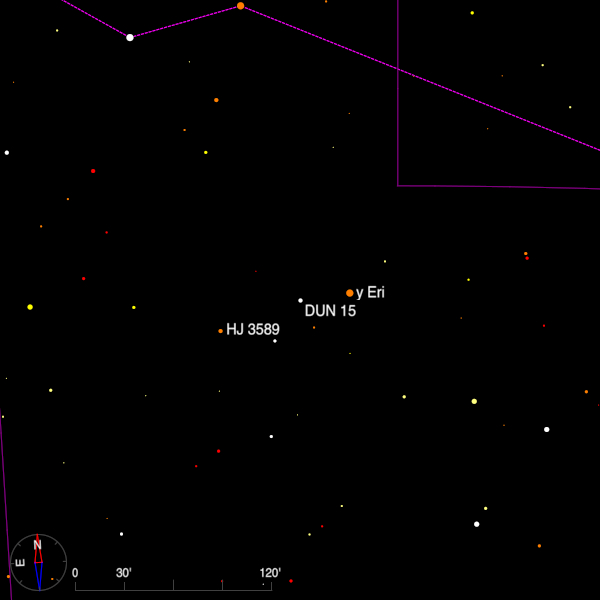
Since John Herschel's measure in 1836, the distance has increased from 4".0 to 7".5 at the current time, whilst the position angle has reduced from 335 degrees to 327 degrees. The stars are both of spectral class A and the Washington Double Star Catalog (WDS) gives the V magnitudes as 6.9 and 7.7. This does seem to be a physical pair as the Gaia EDR3 catalogue lists a parallax for each star which is the same (mean value 4.70 mas = 694 light-years) within the errors.
Moving 1 degree ESE from DUN 15 will bring the observer upon HJ 3589, an unequal pair of magnitures 6.5 and 9.3 with position angle 350 and a current separation of 5".0 but which appears to be slowly decreasing.
Bob Argyle - Double Star Section Director
November 2021 - Double Star of the Month
On the border of Andromeda and Cassiopeia, about 15 degrees north-west of gamma And, is the naked-eye star phi And (01 09 30.12 +47 14 30.6). This has long been known as a close and difficult visual binary, having been discovered by Otto Struve at Pulkova in the 1840s.
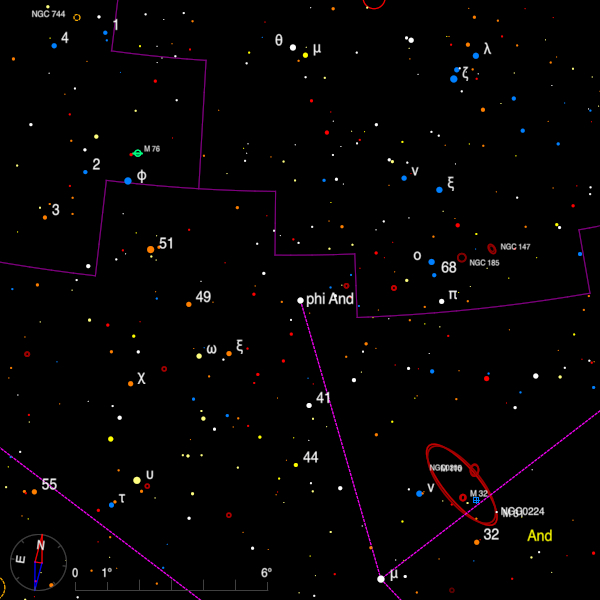
The orbital period is long, a recent estimate put it at 554 years, but at present it is slightly wider than 0".5 and is thus within range of 25-cm, although 20-cm might well show an elongation. The stars are not equally bright, the Washington Double Star Catalog (WDS) gives values of 4.6 and 5.6 for the magnitudes.
Within 2 degrees of phi there are three other double stars marked in the Cambridge Double Star Atlas, 2nd edition. Two of these (MAD 1 and STT 21) will be discussed in this column next year.
The other is BU 397 which lies 40' south-west of phi. The stars are magnitudes 7.5 and 10.3 at PA 142 degrees and separation 8".7. This pair was actually discovered by John Herschel, but S. W. Burnham noted that Herschel had made an error of 1 degree in declination. Burnham also added a fainter and more distant star - 12.9 at 72 degrees and 19".3.
66 Cet (02 12 47.54 -02 23 37.1) is a beautiful wide pair to be found 1.5 degrees WNW of Mira Ceti, the famous long period variable star. Mira reached maximum brightness in August 2021, so judging by previous light curves it is expected to be about V = 7.5 by mid-November.
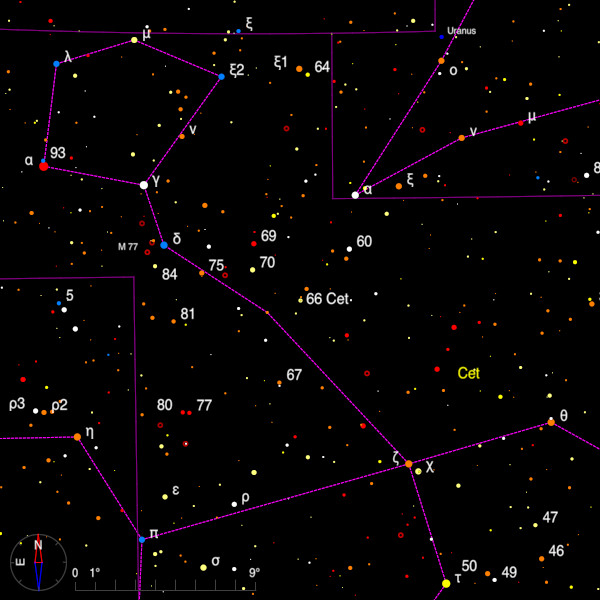
66 Ceti has stars of spectral types F8V and G1V and visual magnitudes 5.7 and 7.7. The position angle of 235 degrees and separation of 16".8 has remained unchanged since 1783 when the pair was noted by William Herschel. This is almost certainly a physical pair, since in addition to very similar parallaxes the two stars have the same considerable proper motion.
In addition, the A component, which was known to be a spectroscopic binary, has recently been resolved by Dr. Andrei Tokovinin at Cerro Tololo using the 4 metre SOAR telescope, The period is 94 days and the angular separation is under 0".02.
A more distant star of V = 11.5 is optical. I found the primary stars to be yellowish and lilac with a 21-cm reflector.
Bob Argyle - Double Star Section Director
October 2021 - Double Star of the Month
The fine pair STF 3053 (00 02 36.1 +66 05 56) is located on the border between Cassiopeia and Cepheus and is about 1 degree south of the large emission nebula Cederblad 214. It is marked on the Cambridge Double Star Atlas 2nd Edition (CDSA2) but not labelled.
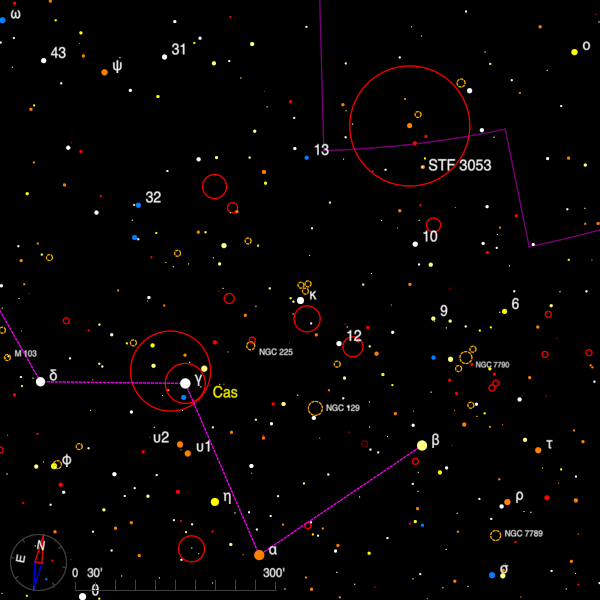
This is an easy object for the small aperture with the components of magnitudes 6.0 and 7.2 currently separated by 15".2 in PA 70 degrees, although the separation has decreased from 18" over 200 years. I have not measured this pair, possibly because the high declination makes access using a German-mounted refractor awkward. There is a third star, V = 11.0, at 99" and 291 degrees.
Gaia EDR3 has pinned down the distance to all three stars, in the case of the main pair to better than 1% - the mean value is 803 light-years. The faint companion is 33 light-years further out, but with a significantly greater error.
One of the double stars which William Herschel included in his last list of discoveries is H N 112, better known as STF 3008 (23 23 45.3 -08 27 36) which lies in Aquarius and is again included in CDSA2 but again is unlabelled. It can be found as the faint point about one degree north following the three stars marked psi, and also, incidentally, one degree due west of the spiral galaxy NGC 7606.
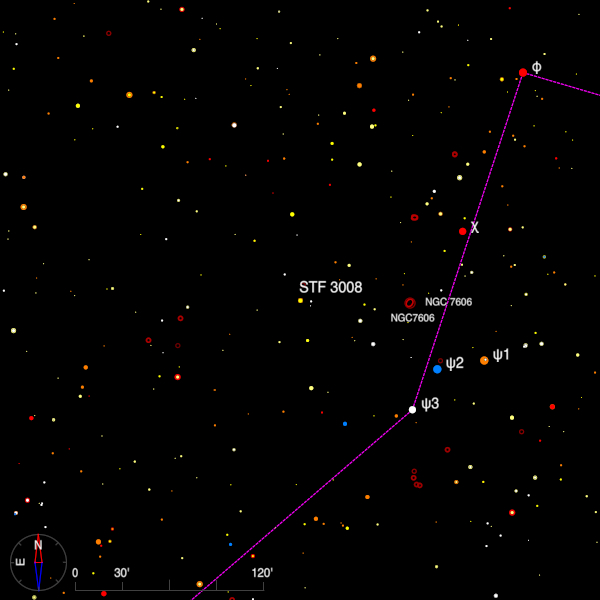
This is certainly an optical pair but is noticeable for the measurable change in aspect over a number of years. I measured this pair with the Cambridge 8-inch three times with the following results: 2000 - 153 degrees, 5".97, 2005 - 151 degrees, 6".27 and 2014 - 149 degrees, 6".67. The stars are magnitudes 7.2 and 7.7 and easily seen in smaller apertures.
Bob Argyle - Double Star Section Director
September 2021 - Double Star of the Month
STF 2883 (22 10 38.8 +70 07 57.2) is located in the pentangle of Cepheus, about 3 degrees following beta Cephei, which is itself a fine pair (see this column for Sept 2012).
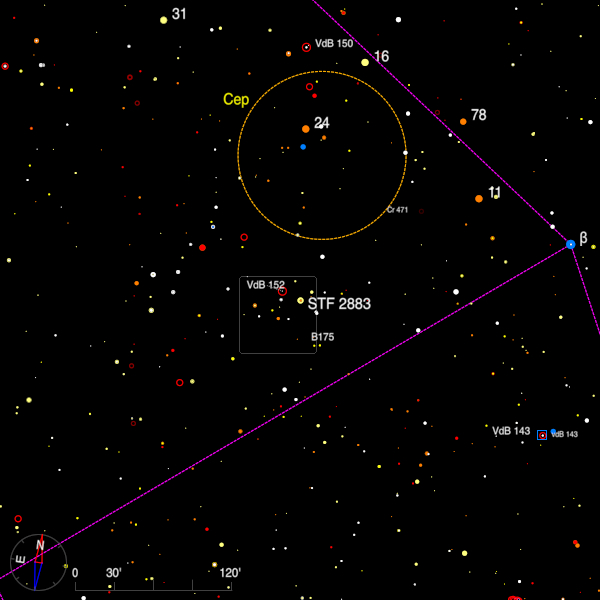
This pair was somehow missed in my early survey carried out in the late 1960s, probably because of its high declination. It also eluded the elder Herschel and only made it into his final double star catalogue of 1822 as H N 121. It was subsequently observed by South and John Herschel and they noted the stars were white and blue with the colours very decided. I measured it with the Cambridge 8-inch in 2003 (253, 14".4) and at the time I noted another fainter and wider pair about 15 arc minutes south-west (7.9, 8.1, 207 degrees, 66").
STF 2883 is almost certainly a long period binary. The distances as they appear in Gaia EDR3 are almost identical and the proper motions are similarly equal. The stars lie 106.29 light-years away. This is a nice pair for the small telescope with the stars shining at magnitudes 5.6 and 8.6.
HIP 110109 (22 18 15.6 -53 37 38) is a Sun-like star of magnitude 5.4 located in the south-western corner of Grus and which can be found six degrees due north of alpha Tucanae.
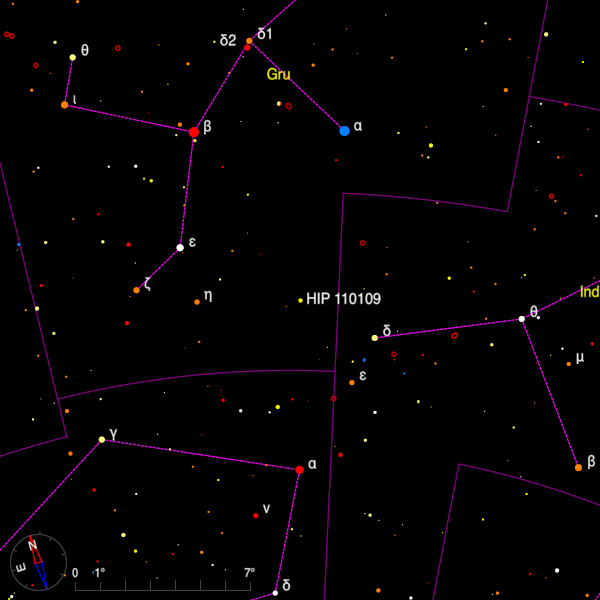
During the period in the late nineteenth century when observers from Harvard were site-testing at Arequipa in Peru, they discovered a number of new double stars and this star appeared in that list (HDO) as number 298. When first observed the magnitude 9.7 companion was 2".5 distant in position angle 10 degrees but since then the stars have closed and the last measurement in 2015 found the companion at 10 degrees and 1".8.
Hipparcos found both stars to have the same distance (45 light-years) within the admittedly large errors on each parallax.
Bob Argyle - Double Star Section Director
August 2021 - Double Star of the Month
I have been following STT358 in Hercules (18 35 33.22 +16 58 32.5) for almost 50 years. In 1970, with the 28-inch refractor at Herstmonceux, a measure gave the values of 168 degrees, 1".7. In 2018 using the Cambridge 8-inch Cooke, the separation had remained virtually unchanged and the position angle reduced to 149 degrees. This fine binary has a period of 380 years according to Wulff Heintz in 1995 and it is currently at 142 degrees and 1".5. The pair will remain within range of 15-cm or so for decades to come, only reducing to 1".3 by 2100 before widening again.
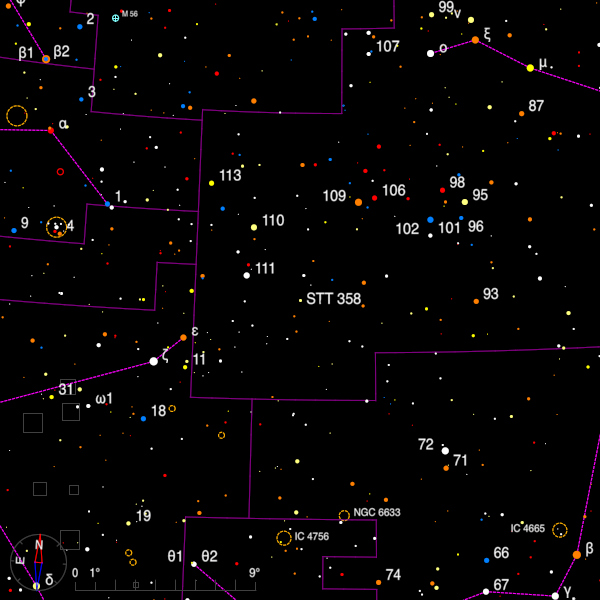
Gaia EDR3 shows that both stars have the same trigonometrical parallax to within the stated errors (±0.1 light-year in each case) and the mean distance of the system is 111.2 light-years. The pair can be found 3 degrees WSW of 111 Her. In 2007 I. N. Reid found a magnitude 12.6 star 349 degrees and 35" from A which is 0.3 light-year further out. This turns out to be an M3 dwarf.
One of the brightest triples in the sky is β Sgr which sits in the extreme south-west corner of the constellation and is unfortunately not visible from the UK. The two brightest components, called β1 (19 22 38.30 -44 27 32, V = 4.0) and β2 (19 23 13.14 -44 47 59.2, V = 4.3) are separated by 21' on the sky and thus easily visible to the naked-eye.
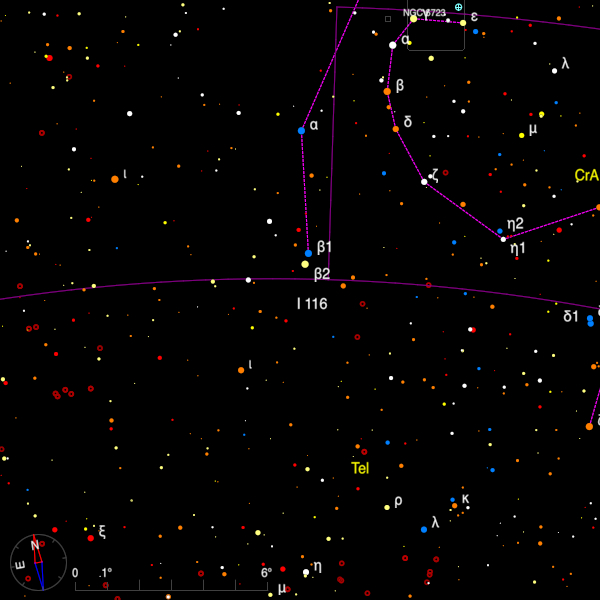
β1 has a magnitude 7.1 companion at a distance of 28" and position angle 76 degrees, and was first noted as double by James Dunlop in 1826. Ernst Hartung thought these stars physically connected and indeed Gaia EDR3 seems to indicate that they lie at a similar distance, but the parallax for A has a very large quoted error, which may be partly due to the star's brightness. Hartung also noted the colours of the components of β1 as bright pale yellow and ashy-white, while Ross Gould found them to be white and yellowish, more in line with the spectral types of B9V and A5V.
Draw a line from β1 through β2, extend it by about 1.5 degrees and you will come upon I 116, a fine triple star which will be well seen with 20-cm. The close pair has magnitudes of 8.6 and 9.4 and they are currently at 24 degrees and 2".7, whilst 16" from A is another 8.6 magnitude. star at PA 190 degrees. The discoverer, Robert Innes, re-visited the system some years later and added a magnitude 13 star only 2".4 from C. This star was last measured in 1960.
Bob Argyle - Double Star Section Director
July 2021 - Double Star of the Month
On summer evenings the beautiful binary star 70 Ophuichi (see this column for July 2008) is well placed for observation. It is part of a triangle of naked-eye stars which also include 68 Oph (= H VI 2), a wide and unequal Herschel pair) and 67 Oph (= BU 1125), a very unequal and close Burnham pair which is now closing. Draw a line from 70 through 68 and extend it by the same distance and you will alight on STF 2244 (17 57 04.32 +00 04 00.0), also a close binary, but more tractable than BU 1125 for the observer with moderate aperture.

The period is 475 years and in mid-2021 the separation is 0".69. The stars are magnitudes 6.6 and 6.9 so 20-cm should be sufficient to see them separated. By 2027 they will start to slowly close again so this is a good opportunity for observation. Note that if you are using the second edition of the Cambridge Double Star Atlas, the star appears as STF 2224. Gaia EDR3 offers no up-to-date information on parallax, but Hipparcos found a distance of 386 light-years but with an uncertainty of 33 light-years.
The components of kappa CrA (alias DUN 222 - 18 33 23.13 -38 43 33.6), on the other hand, probably do form a physical system. The stars, of magnitudes 5.6 and 6.2, are currently 20" apart and lie almost in a north-south direction. When James Dunlop discovered this pair they were closer to 30".
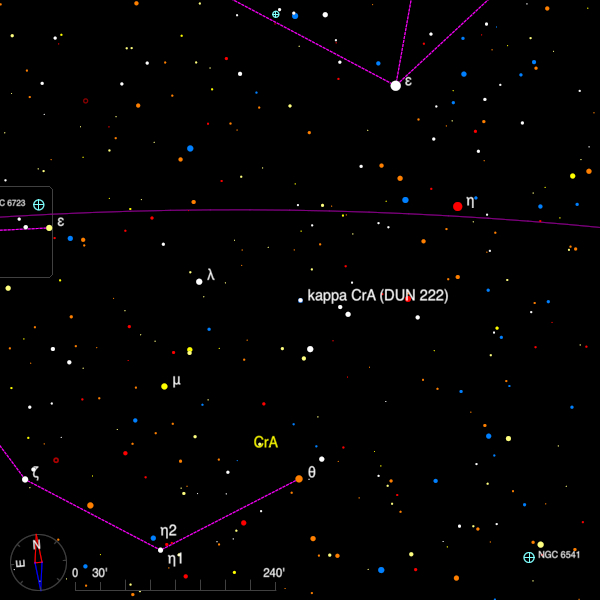
The proper motions from Gaia EDR3 show that the stars are moving in similar directions through space, the radial velocities are very close, and the parallax measurements from the satellite tell us that both stars are about 717 light-years away. Both components are white, being late B in spectral type. The system lies close to the 'Teapot' of Sagittarius and can be found 5 degrees south and slightly east of epsilon Sgr (V = 1.9).
Incidentally, epsilon Sgr has a companion of magnitude 14.3 - discovered by T. J. J. See in 1896 which has been measured only four times since 1896. The current distance is 39".
Bob Argyle - Double Star Section Director
June 2021 - Double Star of the Month
About three degrees north of zeta UMi (magnitude 4.3) is a group of naked eye stars, the most southerly of which is the binary pi1 UMi = STF 1989.
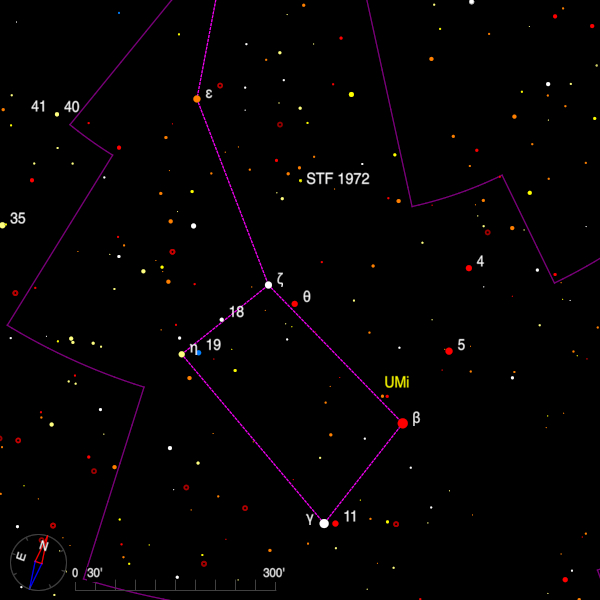
The brightest star in the group is pi2 (magnitudes 6.6, 7.3) which is also a pretty, wide pair STF 1972 (15 29 11.19 +80 26 55.0). (This pair is listed in the notes of the second edition of the Cambridge Double Star Atlas (CDSA2) but not identified with its Struve number on page 1 of the Atlas). CDSA2 notes doubles 6' south-following and 10' north. William Herschel found the pair in 1782 when the separation was 26", whilst a recent measure in 2018 gives 32".
This is actually a physical quadruple system as both bright stars are 71.1 light-years away and each is also a spectroscopic binary. A recent deep imaging investigation, looking for exoplanets has also noted two twentieth magnitude objects within a few arc-seconds of B but the single epoch of observations does not indicate whether they are co-moving or connected to B. The relatively large proper motions of the bright stars has increased the distance to a 11.4 magnitude field star by 55" since 1911.
The southerly objects chose for this month's column are just south of the celestial equator, in the constellation Virgo. In 1781 William Herschel noted a wide unequal pair which appears as H 6 51 (14 57 29.32 -00 11 05.74) in his second list of double stars, published in 1784. He records the position as in Monte Maeneli Heveliana
. In the Hevelius star atlas, Bootes appears to be standing on ground called Mons Maeneli or Mount Maenelus which was a constellation created by Hevelius in 1687.
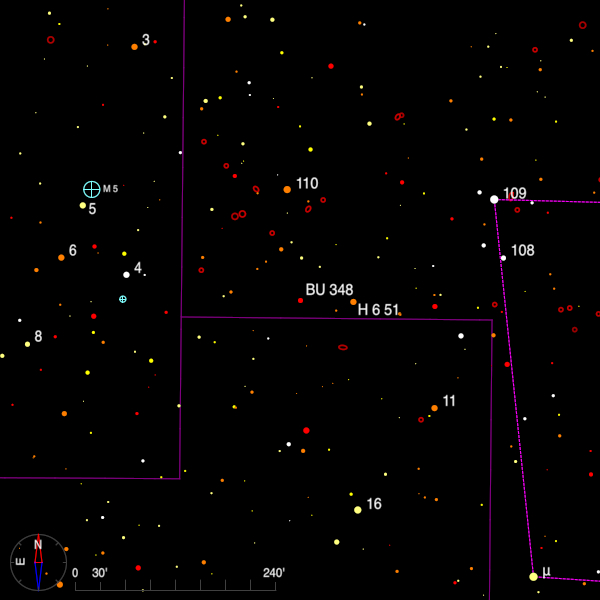
The Washington Double Star Catalog (WDS) catalogue gives V magnitudes of 5.6 and 10.4 with position angle 224 degrees and separation 86". The primary has a strong orange hue, a consequence of its spectral type of K1III. The SIMBAD catalogue calls the bright star 1 Ser and rather surprisingly Gaia EDR3 shows that both stars have the same parallax within the quoted errors, showing that they are 322 light-years away.
Nearby (just over one degree due east) is the much more difficult BU 348 (2 Ser - 15 01 48.92 -00 08 24.9) which requires 30-cm to resolve clearly, although S. W. Burnham discovered it with his 6-inch Clark refractor. Here the stars are magnitudes 6.1 and 7.5 and the current separation is only 0".5. If this is not challenge enough, try and see the 14.5 magnitude star C, 37" distant, which was found by Burnham in 1899. The close pair has a parallax of 3.252 mas corresponding to 1002 light-years.
Bob Argyle - Double Star Section Director
May 2021 - Double Star of the Month
1 Bootis (13 40 40.50 +19 57 20.4) is a star just about visible to the naked eye on a good night. It can be found about 4 degrees WNW of eta Bootis. It is not an easy double star for the small aperture and I have not actually observed it, even thought the primary is a naked-eye object.
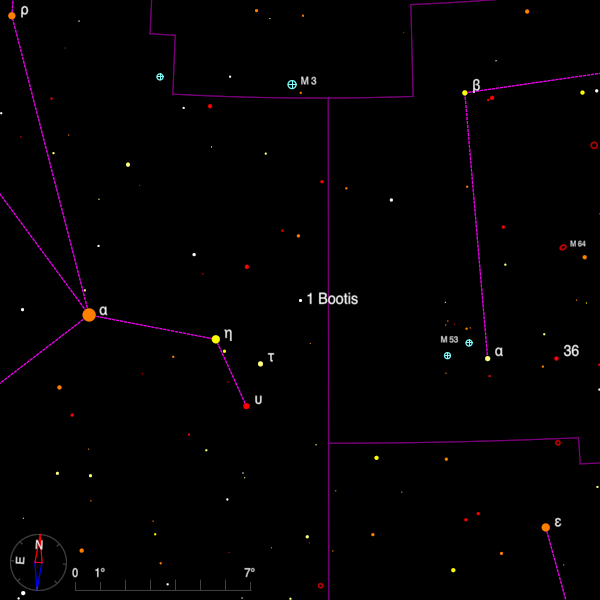
The Washington Double Star Catalog (WDS) gives the magnitudes as 5.8 and 9.6 with the current position angle and separation being 133 degrees and 4.4 arc-seconds. A 15-cm aperture should give a good view of the stars, the primary being white - its spectral class is A1V. There is a faint field star, magnnitude 12.2, 88 arc-seconds away whilst the 7.4 magnitude star at 208 arc-seconds has a similar parallax and proper motion as the stars of the binary. According to Gaia EDR3 the three lie at a distance of 310 light-years.
For the first time in this series, (as far as I know, and deliberately at least!) a binary star is going to be included a second time. This is because it is an exceptional object, about which much has been learned recently so it seems a good time to take another look at alpha Centauri (14 39 36.50 -60 50 02.3).
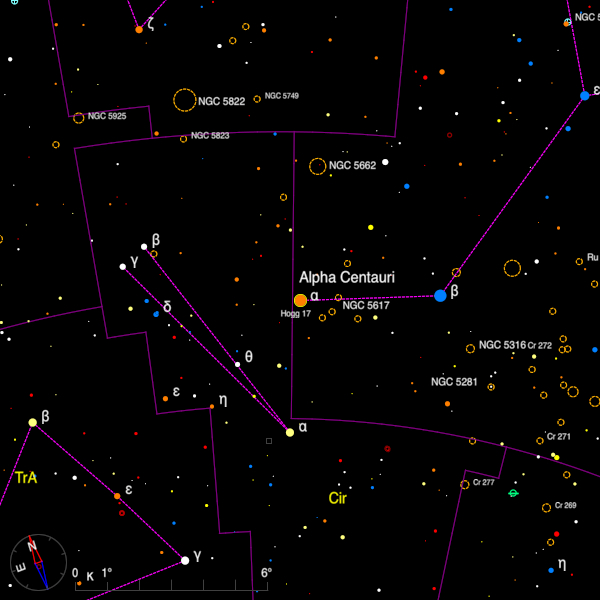
In May 2007, alpha Cen was at PA 235 degrees and 8".4. This month it can be found at 354 degrees and 6".35, although it is now widening, but only as far as 10".4 in 2020, and then it closes to 1".7 in 2038. Extensive direct imaging has been done of both the stars in the bright binary and the physically connected Proxima Centauri.
To date there definitely seems to be one planet orbiting Proxima and recent observations suggest there is a second one. Both bright components have been suspected of having planetary companions and a recent paper purports to show a candidate close to the A component.
The latest data from the Gaia mission - data release EDR3 - includes a measurement of Proxima Centauri. The satellite finds the star to be 4.2465 light-years away with a quoted error of 0.0003 light-years. The main stars are far too bright to have been considered for data reduction at present though it is hoped that this might be done towards the end of the present mission.
Alpha Centauri is always a 'goto' object for the observer fortunate enough to be south of latitude +20 degrees or so. I have seen the stars in the 67-cm refractor at Johannesburg, and they appear like car headlights - dazzlingly bright.
Bob Argyle - Double Star Section Director
April 2021 - Double Star of the Month
35 Sex (10 43 20.91 +04 44 51.6) lies south of the main body of the constellation of Leo and about 5 degrees SSE of the magnitude 3.9 star rho Leonis. It is a fine pair with the principal stars shining at magnitudes 6.2 and 7.1 and the current separation of 6".8 puts the pair within range of small apertures.
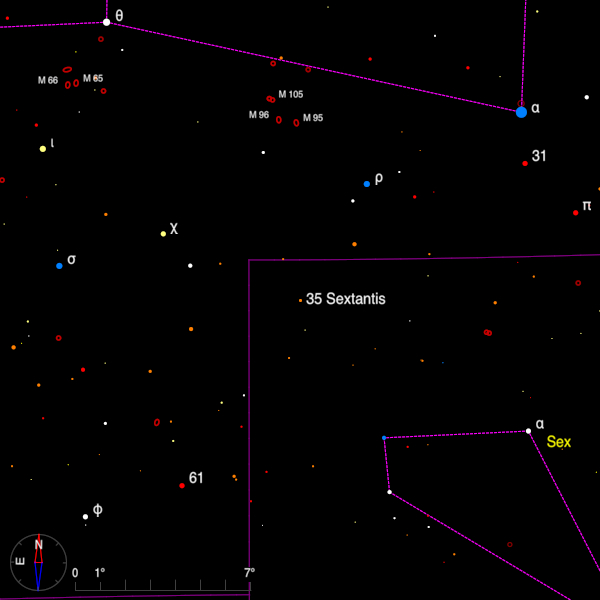
The angular motion in 2 centuries has amounted to about 2 degrees with the stars closing in very slowly. There seems to be no doubt that this is a binary pair - the Gaia EDR3 parallax data show that they are at 687 and 718 light-years respectively each with a formal error of about 22 light-years. Each star appears to be an early K giant which would imply that they should appear orange or deep yellow. Webb found colours of yellow and blue and later yellow and ruddy and noted that there was Much difference as to colours
.
Just over 5.5 arc-minutes away from AB in PA 210 degrees is a star of magnitude 8.1, which is the long period binary A 2769 - 8.4, 9.4, 207 degrees, 0".5.
Nestling within the bounds of the five main bright stars of Crux, CPO12 (12 28 16.88 -61 45 55.6) can be found 1.5 degrees N. of alpha Crucis (Acrux) and 20 arc-minutes east of the open cluster NGC 4349. The stars are V magnitudes 7.3 and 8.2 and with a current separation of 2".1 they can be easily seen in 75 to 100-mm aperture.
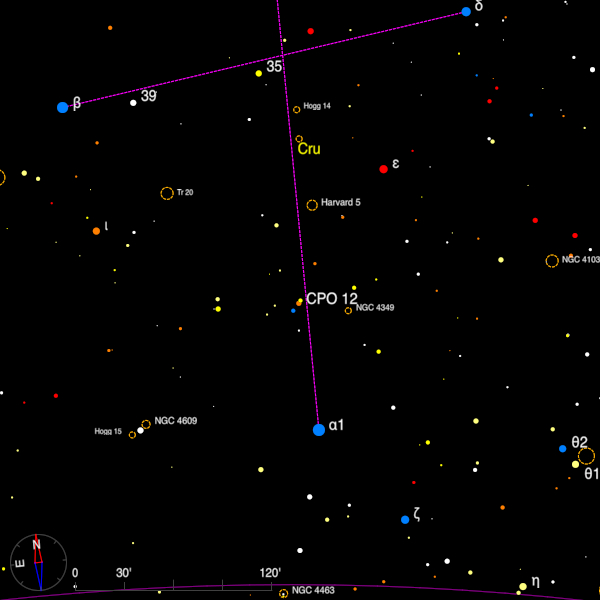
Since the pair was discovered in 1880 the position angle has reduced from 271 degrees to 183 degrees and a preliminary orbit by Dr. Andrei Tokovinin suggests that the period is about 690 years. In 1939, Robert Rossiter, using the 27-inch refractor at Bloemfontein in South Africa, noted that the B star was a close double. The Washington Double Star Catalog (WDS) gives a magnitude of 8.8 for each component. This is also a binary system but the stars are about ten times closer than A-B. The period is 28 years and the stars are currently 0".18 apart. By 2030 they will have reached their maximum separation of 0".24. There is another, much fainter companion - a star of magnitude 13.7 at 331 degrees and 7".9.
Acrux, of course, is a magnificent pair - see the column for April 2007 for more details.
Bob Argyle - Double Star Section Director
March 2021 - Double Star of the Month
STF 1426 (10 20 32.32 +06 25 47.6) is a long period binary located about six degrees south-south-east of Regulus. More specifically it is about 45' preceding the 6.1 magnitude star 43 Leo.
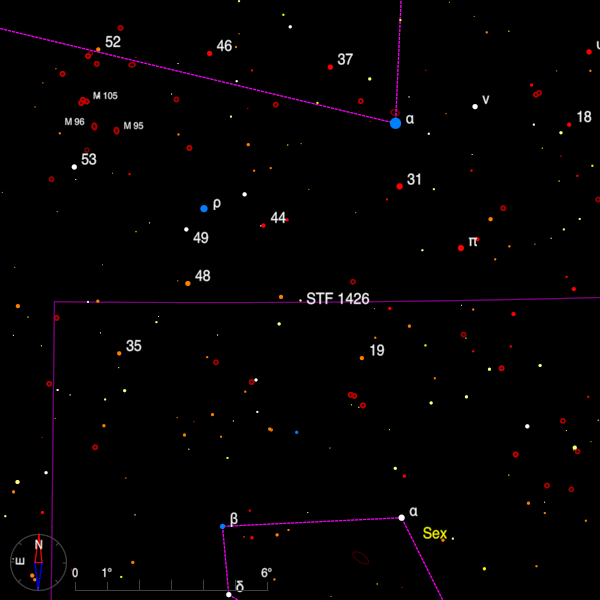
It is also a triple with the C component (magnitude 9.4) having been first found by Herschel in 1782. The stars are magnitudes 8.0 and 8.3 and the current position is 317 degrees and 0".9, so 15-cm is needed to see them clearly divided. The stars have moved prograde by 60 degrees and widened from 0".6 since discovery. The C star is a relatively easy object for the small aperture and is currently at 9 degrees and 8", and Asaph Hall added a magnitude 12.6 with the Washington 26-inch which is currently at 41 degrees, 39".
The catalogue orbit for AB gives a period of 2209 years and predicts that the stars will now slowly close reaching 0".6 around 2175. One degree south-east is the wide and unequal optical pair SHJ 115, the primary of which has the significant proper motion of 0".25 per year and a distance of 190.6 light-years.
The pair chosen for the southern part of this column offers a real challenge to observers. BU 208 (08 39 07.90 -22 39 42.8) was one of the pairs which S. W. Burnham found with his famed 6-inch Clark refractor.
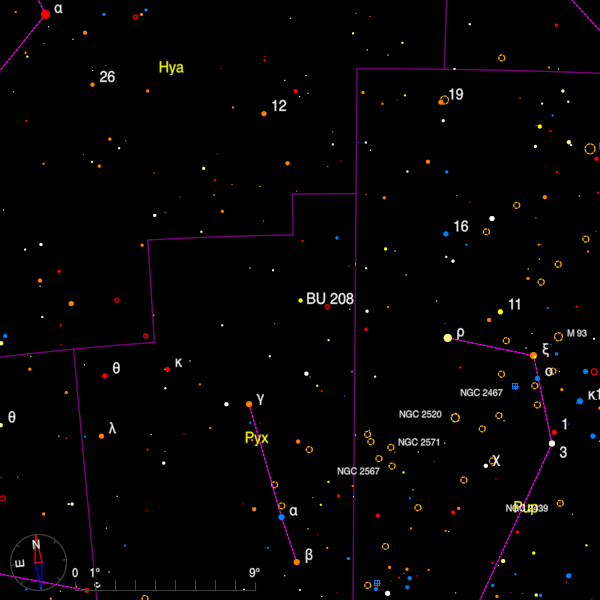
When discovered the pair was 1".3 apart but later obserations saw the stars close to 0".25 and the period was recently found to be 123 years. The stars have magnitudes 5.4 and 6.8 and in early 2021 they can be found at 77 degrees and 0".34, but they are closing so any plan to resolve them would benefit from an early attempt!
Gaia EDR3 shows a parallax for the system as a whole which converts to a distance of 64 light-years, and its considerable annual proper motion of half an arc-second per year is continuing to widen the distance to a field star of magnitude 11.4 currently 121" away.
In addition to reports of the spectroscopic binary nature of the A star, the Washington Double Star Catalog (WDS) also contains a note on another component which has an H magnitude, of 13.7 at a distance of 7".5. It was noted whilst using the Subaru telescope on Mauna Kea to look for debris disks and planetary bodies. The authors noted it was near the edge of the detector and they do not give much weight to it.
Bob Argyle - Double Star Section Director
February 2021 - Double Star of the Month
In December 1968 I was observing with friends in the back garden of a house in Newcastle-upon-Tyne using a 12-inch reflector. We looked at a number of double stars that night, including phi2 Cancri = STF 1223 (08 26 47.08 +26 56 07.8) and 24 Cancri = STF 1224 (08 26 39.82 +24 32 03.7). These two pairs form a kind of wide double-double and can be found in northern Cancer.
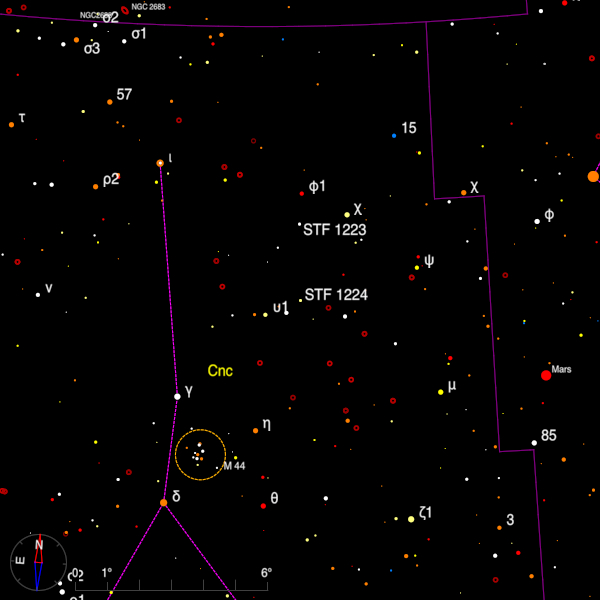
Starting with the beautiful pair iota Cancri, move about 4 degrees SE to find phi2. This is a pair of magnitude 6.9 and 7.5 stars separated by 5".7 and currently at PA 53 degrees. With the 12-inch I noted that the stars appeared white and lilac at a power of x208. Gaia indicates that these stars are at the same distance from us (347 light-years).
STF 1224 is the brighter of the two pairs with the components having V = 5.2 and 6.2. The separation is 5".2 and the position angle 219 degrees. I recorded both stars as being blue-white. Robert Aitken found that the B component was a very close binary of short period. The BC pair revolves in just 21.8 years and the separation stays close to 0".15 throughout the cycle. The Gaia EDR3 catalogue gives a parallax for the A component of 14.429 mas giving a distance of 226 light-years.
The magnitude 2.5 star pi Puppis (07 17 08.56 -37 05 50.9) lies in a rich area of the Miky Way which is part of the Vela-Puppis star forming region. It is surrounded by a number of naked-eye stars and the open cluster Collinder 135.
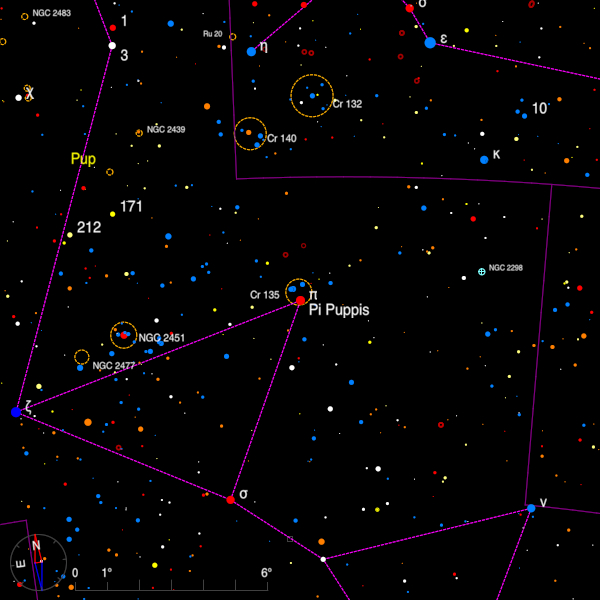
Pi, which is distinctly red, is a close, very unequal double star which was discovered by Hipparcos in 1991 but whose nature does not appear to have been confirmed since. Along with a magnitude 7.9 star some 67" distant in PA 213 degrees it also forms the pair DUN 43.
To the north of pi are the bright stars upsilon 1 (V = 4.7) and upsilon 2 Puppis (V = 5.1) which are 4 arc minutes apart. Both these bright stars are variables. Upsilon 1 is also known as NV Puppis whilst upsilon 2 is NW Puppis. A V = 8.8 star lies at 119" and 215 degrees from B whilst William Jacob, observing from India, discovered a fainter companion (V = 9.1) to C at 3".1 and 209 degrees; this pair is now known as JC 10. There is another open cluster nearby called UBC7 and its possibly binary relation with Collinder 135 has been discussed.
Bob Argyle - Double Star Section Director
January 2021 - Double Star of the Month
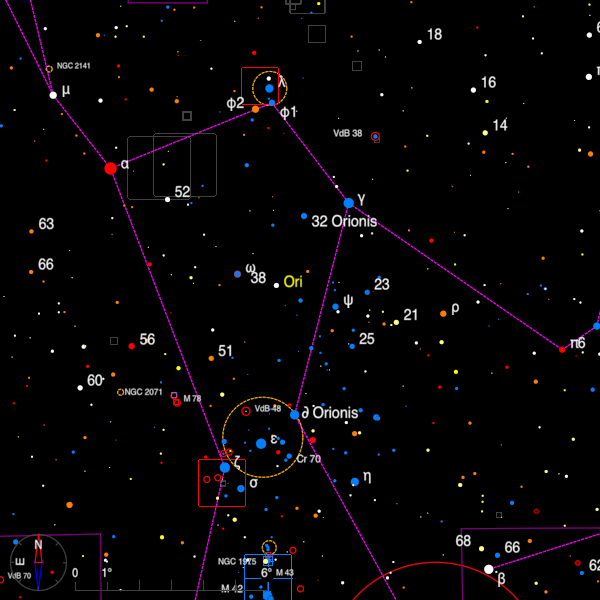
32 Orionis (05 30 47.06 +05 56 53.3) is easily found. It follows, and is slightly south of, Bellatrix (gamma Ori) by about 2 degrees. It was picked up by William Herschel on Jan 20, 1782 and he noted that the stars were Considerably unequal
and The distance or black division between the two stars with 278 is about ¼ diameter of L(arge star)…
. Herschel noted that the position angle was 232 degrees 10'. During the following century, measurements of 32 Ori showed the stars closing down to a distance of 0".3 before slowly increasing again to the current distance of 1".3.
Thomas Lewis in his 1906 volume on the Struve stars thought the motion was explained by the proper motions of the two stars whilst van den Bosin 1962 also thought that the stars were not associated. The USNO Orbit catalogue gives a period of 614 years and predicts that the stars will widen until about 2100 before closing again. Gaia EDR3, unfortunately, does not help since it contains only an observation of the brighter component. The stars have V magnitudes of 4.4 and 5.8 and should be nicely seen in 10-cm aperture.
Six degrees due south of 32 Ori, and just a little below the celestial equator is Mintaka, or delta Orionis (05 32 00.40 -00 17 56.7, V = 2.4), the most westerly of the three Belt stars.
For the small telescope, the magnitude 6.8 companion (actually component C) located 52" away in PA0 degrees is an easy object to see. This star is itself a spectroscopic binary but it seems to be unassociated with its much brighter neighbour. Gaia EDR3 gives the distance of C as 1245 light-years and whilst the position of the A component is in the catalogue, there is no information on either parallax or proper motion. Hipparcos in 1997, however, found a distance of around 690 light-years, so it seems almost certain the stars are unassociated.
The bright star is a close triple system. In 1978, Wulff Heintz using the 24-inch Sproul refractor, found a close visual companion at a distance of 0".2 which has a visual magnitude of 3.8; a preliminary orbit gives a period of 346 years. These two stars are very bright and hot, late O-type giant stars. In addition A is also an Algol-type eclipsing system. In 1877, Sherburne Burnham found a magnitude 14 companion (B) at 229 degrees and 33".
Bob Argyle - Double Star Section Director